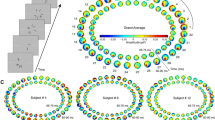Abstract
Brown and colleagues (1994) found that most evoked potential studies provide evidence of faster interhemispheric relay from the right to the left hemisphere, as determined from N160 latencies derived from parietal and occipital electrode sites. The experiment reported here was designed to complement those findings by 1) analyzing more electrode sites (several frontal, temporal, and central sites in addition to the previously investigated sites) and more waveforms (P1 and P2 waves);3) introducing analysis of amplitude data;4) carrying out site-specific and experiment-wise inference tests of putative interhemispheric relay asymmetry. We found that all of the conclusions of Brown and colleagues, regarding latency effects, could be extended to the ensemble of electrode sites and waveforms. However, amplitude effects were significantly compatible with stronger (though slower) relay from the left to the right hemisphere.
Similar content being viewed by others
References
Achim, A., Braun, C.M.J. and Potvin, C. Separation of stimulus and response locked ERP components in reaction time tasks. Dynamical Neuroscience Workshop, Satellite Symposium of Neuroscience, Boca Raton, (Florida), 1994.
Baseler, H.A., Sutter, E.E., Klein, S.A. and Carney, T. The topography of visual evoked response properties across the visual field. Electroenceph. Clin. Neurophy., 1994, 90: 65–81.
Bisiacchi, P., Marzi, C.A., Nicoletti, R., Carena, G., Mucignat, C. and Tomaiuolo, F. Left-right asymmetry of callosal transfer in normal human subjects. Beh. Brain Res., 1994, 64: 173–178.
Bötzel, K., Plendl, H., Paulus, W. and Scherg, M. Bereitschaftpotential: Is there a contribution of the supplementary motor area? Electroenceph. Clin. Neurophys., 1993, 89: 187–196.
Braun, C.M.J. Estimation of interhemispheric dynamics from simple unimanual reaction time to extrafoveal stimuli. Neuropsych. Rev., 1992, 3: 171–212.
Braun, C.M.J., Villeneuve, L. and Achim, A. Balance of cost in interhemispheric relay in the Poffenberger paradigm: Evidence from omission errors. Neuropsychology, 1996, 10: 1–8.
Braun, C.M.J., Achim, A. and Villeneuve, L. Topography of averaged electrical brain activity relating to interhemispheric dynamics in normal humans: Where does the critical relay take place? Int. J. Psychophysiol., 1998, in press.
Brown, W.S. and Jeeves, M. Bilateral field advantage and evoked potential interhemispheric transmission time. Neuropsychologia, 1993, 31: 1267–1281.
Brown, W.S., Larson, E.B. and Jeeves, M.A. Directional asymmetries in interhemispheric transmission time: evidence from visual evoked potentials. Neuropsychologia, 1994, 32: 439–48.
Brunia, C.H. and Van den Bosch, W.E. The influence of response side on the readiness potential prior to finger and foot movements: A preliminary report. Sixth International Conference on Event-Related Slow Potentials of the Brain (EPIC VI): Motor control (1981, Lake Forest/Chicago, Illinois). Ann. New York Acad. Sci., 1984, 425: 434–437.
Clarke, J.M. and Zaidel, E. Simple reaction times to lateralized light flashes. Brain, 1989, 112: 849.
Clement, R.A., Flanagan, J.G. and Harding, G.F.A. Source derivation of the visual evoked response to pattern reversal stimulation. Electroenceph. Clin. Neurophys., 1985, 62: 74–76.
Degg, C., Slaven, A. and Armstrong, R.A. Topographic mapping and source localization of the pattern onset visual evoked magnetic response. Brain Topogr., 1992, 5: 11–16.
Fennell, E.B. Handedness in neuropsychological research. In: J.H. Hannay (Ed.), Experimental techniques in human neuropsychology. New York: Oxford University Press, 1986.
Gomez-Gonzalez, C.M., Clark, V.P., Fan, S., Luck, S.J. and Hillyard, S.A. Sources of attention-sensitive visual event-related potentials. Brain Topogr., 1994, 7: 41–51.
Harding, G.F.A., Janday, B. and Armstrong, R.A. Topographic mapping and source localization of the pattern reversal visual evoked magnetic response. Brain Topogr., 1991, 4: 47–55.
Hoptman, M.J. and Davidson, R.J. How and why do the cerebral hemispheres interact? Psych. Bull., 1994, 116: 195–219.
Hoptman, M.J., Davidson, R.J., Gudmundsson, A., Schreiber, R.T. and Ershler, W.B. Age differences in visual evoked potential estimates of interhemispheric transfer. Neuropsychology, 1996, 10: 263–271.
Iacoboni, M., Fried, I. and Zaidel, E. Callosal transmission time before and after partial commissurotomy. Neuroreport, 1994, 5: 2521–2524.
Jeeves, M.A. A comparison of interhemispheric transfer times in acallosals and normals. Psychon. Sci., 1969, 16: 245–246.
Kutas, M., Hillyard, S.A., Volpe, B.T. and Gazzaniga, M.S. Late positive event-related potentials after commissural section in humans. J. Cogn. Neurosci., 1990, 2: 258–271.
Marzi, C.A., Bisiachi, P. and Nicoletti, R. Is interhemispheric transfer of visuomotor information asymmetric? Evidence from a meta-analysis. Neuropsychologia, 1991, 29: 1163–1177.
Nagamine, T., Toro, C., Balish, M., Deuschl, G., Wang, B., Sato, S., Shibasaki, H. and Hallett, M. Cortical magnetic and electric fields associated with voluntary finger movements. Brain Topogr., 1994, 3: 175–183.
Pfurtscheller, G., Neuper, C. and Berger, J. Source localization using event-related desynchronization (ERD) within the alpha band. Brain Topogr., 1994, 6: 269–275.
Poffenberger, A.T. Reaction time to retinal stimulation with special reference to the time cost in conduction through nerve centers. Arch. Psychol., 1912, 23: 1–73.
Potvin, C., Braun, C.M.J. and Achim, A. Distinct functional channels in interhemispheric relay: Experimental evidence. J. Int. Neuropsych. Soc., 1995, 184: (Abstract).
Rugg, M.D., Lines, C.R. and Milner, A.D. Visual evoked potentials to lateralized visual stimuli in two cases of callosal agenesis. J. Neurol. Neurosurg. Psychiatr., 1985, 48: 367–373.
Saron, C.D. and Davidson, R.J. Visual evoked potential measures of interhemispheric transfer time in humans. Beh. Neurosc., 1989, 103: 1115–1138.
Vaughan, H.G., Costa, L.D. and Ritter, W. Topography of the human motor potential. Electr. Clin. Neurophys., 1968, 25: 1–10.
Woldorff, M.G. Distortion of ERP averages due to overlap from temporally adjacent ERPs: Analysis and correction. Psychophysiol., 1993, 30: 98–119.
Author information
Authors and Affiliations
Rights and permissions
About this article
Cite this article
Braun, C.M., Villeneuve, L. Topographical Analysis of Homotopic Interhemispheric “Relay” Asymmetries in Visual Evoked Potentials. Brain Topogr 11, 223–232 (1999). https://doi.org/10.1023/A:1022285813070
Issue Date:
DOI: https://doi.org/10.1023/A:1022285813070




